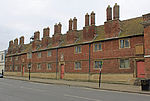Taunton and Somerset Hospital
Buildings and structures in TauntonDefunct hospitals in EnglandHospitals established in 1812

Taunton and Somerset Hospital was a hospital in Taunton, Somerset.
Excerpt from the Wikipedia article Taunton and Somerset Hospital (License: CC BY-SA 3.0, Authors, Images).Taunton and Somerset Hospital
East Reach,
Geographical coordinates (GPS) Address Nearby Places Show on map
Geographical coordinates (GPS)
| Latitude | Longitude |
|---|---|
| N 51.0156 ° | E -3.0917 ° |
Address
East Reach
TA1 3ES , Lambrook
England, United Kingdom
Open on Google Maps








